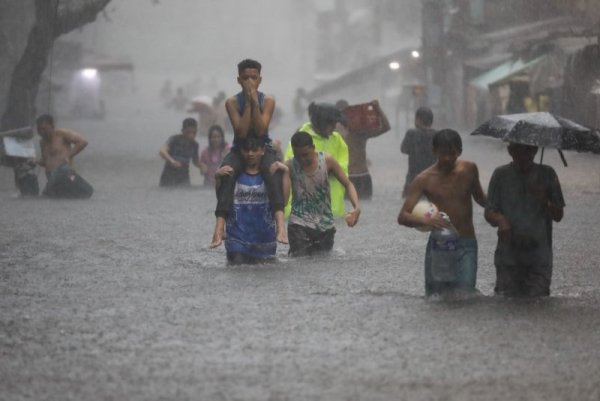
Filipinos in Quezon City, Metro Manila, wade through flood waters in July after Typhoon Gaemi dumped rain in extreme volumes that a major new study published Wednesday says is linked to an increased risk of death in the 14 days after such rainfall events. File photo by Rolex Pena/EPA-EFE
A new observational study published Wednesday of more than 100 million deaths from all causes across all six continents over four decades has found a heightened mortality risk among people who live in areas that experience extreme rainfall.
Overall, a day of extreme rainfall with a five-year return period — expected intervals between events — was associated with an 8% increase in all-cause deaths, a 5% increase in cardiovascular deaths and a 29% increase in respiratory deaths over 14-days after the rainfall event, according to the research published in the British Medical Journal. Advertisement
The study analyzed daily mortality records and rainfall data from 645 locations in 34 countries or regions, comprising a total of 109,954,744 all-cause, 31,164,161 cardiovascular and 11,817,278 respiratory deaths from 1980 to 2020.
Environmental and epidemiology researchers from the Helmholtz Institutes in Munich, Germany, said climate change was intensifying the frequency and severity of short-term rainfall events, and that new evidence was coming out that suggested “a compelling link between rainfall events and adverse health outcomes, particularly transmission of infectious diseases.”
The study controlled for local climate type, rainfall variability, vegetation cover and other factors that might impact the association, but not for demographics including age, sex, race, whether people were urban or rural, or specific clinical settings, which were not collected. Advertisement
Looking deeper into the data, the researchers found moderate to high rainfall actually conferred health-protective effects likely due to lower air pollution and people staying inside, but that was nullified if the rainfall was extreme and was therefore associated with a heightened risk of harm.
The main threat from extreme rainfall levels was in damage to infrastructure, water contamination and coming in to contact with pathogens with higher risks of deaths after extreme rainfall events identified in locations at which rainfall ordinarily does not vary much or vegetation cover is scant.
The authors stressed that causality was not proven due to the findings being drawn from an observational study of studies and geographically tilted toward east Asian, Europe and North American settings.
However, they argued their findings make a compelling case for coordinated public health strategies to mitigate the wide-ranging impacts of extreme rainfall on health.
“This is especially important considering the well-established trend of increasing short-term rainfall intensity as a result of climate change,” they added.
Tsinghua University associate professor John Ji warned against complacency over taking action to address the climate change linked to more extreme rain, even though the science was conclusive.
Welcoming the study in an editorial published alongside the study, Ji said health professionals are ideally placed to motivate action on the climate, educating their patients about climate-related health risks and helping develop community resilience. Advertisement
“People often forget the lessons of scarcity during times of abundance — a risky form of amnesia for climate change,” Ji said.
‘The stakes are far too high, for when it rains, it pours — and in this era of escalating climate extremes, it will pour harder than ever before.”